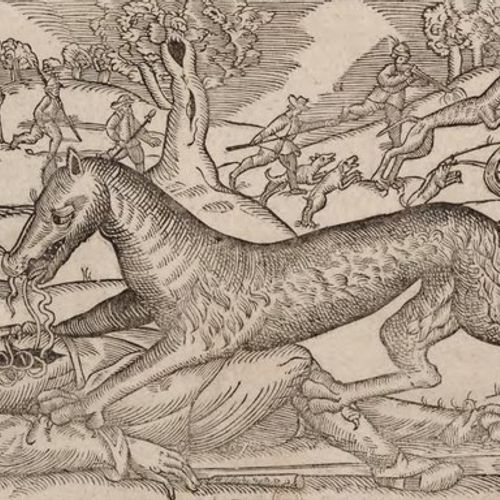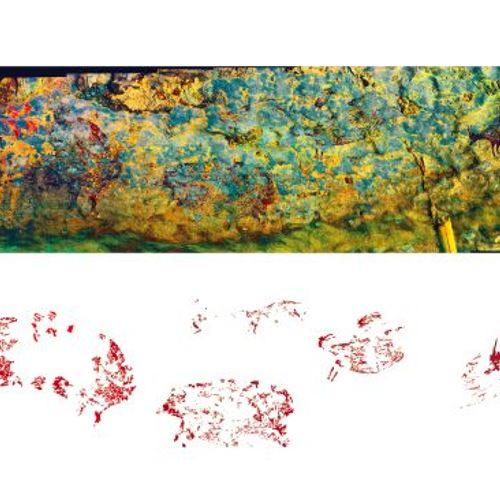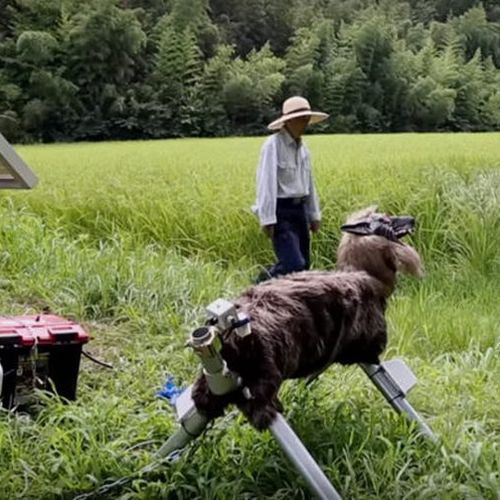
| Added | Mon, 07/08/2017 |
| Источники | |
| Дата публикации | Sun, 06/08/2017
|
| Феномены |
Volkodlak, werewolf, volkolak, vovkulak, in Slavic mythology, the wolf man; the werewolf, the sorcerer, able to transform into a wolf and wolves to draw in other people.
The legend of the werewolf is common to all the Slavic peoples. The ideas about the werewolf combines the features of a folk image, and borrowing from ideas of Christian demonology.
Exceptional archaic notions about werewolves evident from the fact that in other Indo-European traditions (particularly Hittite) turning the groom into a wolf associated with the common form of marriage by kidnapping (forcible withdrawal of the bride).
The antiquity of this image is also confirmed by the chronicle of 1282, which tells of the werewolf, which "drives the clouds and izedaet the moon" (Slavs kept the faith of the Magi-oblikovala that transformed into wolves, went to heaven and called rain or disperse clouds). According to F. Buslaev, "the rest of this tradition hitherto preserved in the proverb: "the Gray wolf in the sky the stars catches."
In contrast to the mythology of the peoples of Europe, the Slavs, the werewolf was originally a positive character, and the fact that lycanthropy was perceived as a normal phenomenon. Unusual, Yes, but not in any way — not terrible and awful.
This is indirectly confirmed by the ancient Russian conspiracy, recorded Saharovym:
"At sea, on the ocean, on the island of Buyan, in a hollow glade shines a month on an aspen stump, into the green forest, in the wide valley. Around the stump goes shaggy wolf, on the teeth he had all the cattle are horned while in the forest the wolf comes, and in the Vale the wolf does not ferment. Month, month gold horns! Melt the bullets, pricopi knives, ismodal clubs, allow the fear to the beast man and the reptile, to the gray wolf did not take, warm skins with him flogged. My word hard, sleep tight and Herculean strength."
Appeal to the wolf was the assimilation of one of the most revered and powerful, giving the supernatural beasts. The name of this beast was so sacred that it was impossible to say out loud, so instead of "wolf" was saying "fierce" and men of some tribes called "lutici". The ability to turn into a wolf of ancient times were attributed to "very strong" witches and, apparently, was a necessary part of certain rituals.
"Back," "obernutsya" (developing) often meant "to turn over", that is to parechovirus, "tossing through" or through the conventional line. "Turning around", as if a person turned over with the side of his being, which is attached to the higher powers of the world to the revered beasts, birds, fishes — "ancestors, relatives, and patrons". In narratives about werewolves, the line between man and beast — it is a narrow strip of a knife, rope, twigs, basically, she runs through the werewolf: he is both man and animal at the same time
The practice of lycanthropy was so widespread among the Slavic tribes that Herodotus describes the annual transformation newrow (Slavic tribe that supposedly lived on the territory of Belarus) for a few days to the wolves as a matter of course. And Slavic heroic epos, in General, characterizes the main character of the werewolf as a being of divine origin.
At the birth of the Russian hero-wolf of the Volga Vseslavovich:
As the sky brightened Prosveta month
And in Kiev was born a mighty warrior,
How would young Volh Vseslav'evich.
Have imitated cheese land
Strekosa glorious Kingdom Indian,
And sinea sea solubilise
For-for the birth bogatyrskaja,
Young Volga Of Vseslav'evich.
Such disasters and natural phenomena that accompanied the birth of the natural Slavic deities. Many researchers draw Parallels (albeit highly conditional), according to which Volh Kyiv Prince Oleg, who was considered prophetic ( in other words to denote the werewolf was a word formed from a verb vedati — "know": Ukr.vsun — "wolf-werewolf", etc.-Czech.vedi — "wolf-werewolf", the word. vedomci, vedunci, vedarci — "wolves-werewolves"). However this Prince-a werewolf and was no less famous Vseslav of Polotsk (second half of 11th century) that "...the princes of the city ryadili, and he in the night a wolf prowled... Hersony great wolf path pararescue..." (lay).
Other Slavic werewolf, the hero of Belarusian and Serbian epics, the Serpent was the Fire Wolf. His image also dates back to the Slavic myth of the hero-wolf. It is born from the Fiery Serpent, is born in human form, "the shirt" or "wolf fur" — a sign of miraculous origin. Can turn into a wolf and other animals, including poultry; performs feats of using the ability to turn himself (and the team) in animals.
Many of the creatures of lower mythology also had a penchant for shape-shifting Goblin, for example, is often turned into a white wolf (white carica) or wolf shepherd. With the adoption of Christianity all the old gods were overthrown and declared to be demons. Not spared this fate and werewolves, which of the deities of the helpers and heroes-heroes became terrible monsters of nightmares. Among the Russian peasants of the twentieth century did the belief in lycanthropy, in General, is declining, although the stories about werewolves — the wolves and bears are still popular in some parts of Russia.
SIGNS OF A WEREWOLF
The main feature of the werewolf as hero, wolf, is visible from the birth of the "wolf hair" (serbohorv. Wucka of dlaka, Slovenian. Volcja dlaka) on the head (compare old Icelandic identical sign — vargshar, "wolf hair" werewolf). Also get to know the werewolf is possible because they have the knees of the hind legs turned forward, like a man, not as animal. Forced werewolves to people not harmed, except those who "messed up". Those should not get in their way. When a werewolf is suitable to drink to the water, there is not a wolf and human form. Featured animals-werewolves unusual behavior, at least — on some features in their appearance (white stripe on the neck of the wolf, white color skin, no tail).
HOW TO MAKE
The first known method of transformation was wrapping with the help of spells and rituals ("wisdom"): Vapory learn from the Volh to wisdom: and wisdom learned to Turn clear Falcon, To another kind of wisdom he learned Volh to Turn into a wolf, To thirds-of the wisdom learned to Volh Turn into chestnut tour — the Golden horn.
Throwing out. The most common way. Man is endowed with "supernatural" abilities, becomes a wolf, "spreading" (rolling over) through the thrust in a smooth stump or the ground a knife or an ax. Has been transmitted through the rocker arm, the stump, hoops, twelve knives, a rope, a tree branch, the fire on the furnace hearth, through the core of a fallen tree or just parechovirus "against the sun", etc. Ordinary people can become wolves, crossing zagovornye sorcerer thing. In order to turn a human into a wolf, a wizard or witch throw him animal skins, ribbon or belt (tying them).
Putting on wolf skins. One of the oldest methods of conversion practiced by the Magi. The transformation at weddings. It was believed that especially powerful witches can "let the wolves" the whole of the Bridal train. To do this, the sorcerer takes so many straps and urine, how to train individuals, whispers on these things spell, and who then will belt this belt, he becomes a wolf. Sometimes the witch dig traveling from the crown of the road train in small rovik: scarcely had the train will drive at this dip as horses fall dead, and people run away in the animal image, etc.
The transformation of "the word mother". Same as turning on the curse. The werewolves transformed by the word mothers should in no case eat raw meat, otherwise the wolves will forever remain. Werewolves are children, kidnapped by the evil force.
WAYS TO RETURN HUMAN FORM
- To spread across a magic item in the opposite direction.
- To get the magic axe from the stump.
- The wolf becomes human after a time, appointed by the spell.
- Cover of the wolf in human clothing.
- Some wizards impose special conditions for the return of the human form: the bilicki soldiers makes the deceased priest's wife, who drew the wedding train wolves, specify the path to their salvation; for this it is necessary to collect werewolves:
"I'll give you a tube. This potrubi — they all come to you. You tear off a bit from the shroud. This smoke — they again people will." (Pskov oblast).
- Feed the werewolf the "blessed food", i.e. a meal, which blessed. Tie the werewolf belt with knots, knotting who were presumptively "Lord, have mercy."
WAYS TO PROTECT AGAINST WITCHES AND WEREWOLVES
The newlyweds and trains are always guarded by specially invited a witch beilives and friend, "the best man of the groom", the South called "wolf". To prevent yourself from a werewolf (first of all — a werewolf-sorcerer) could, striking him a swinging blow, crippling (injuring werewolf, Podkova the witch-horse). From werewolves defended "snake axe" (an axe, which killed the snake). If you steal the clothes of the sorcerer or the object through which it turns, the werewolf will not be able to take human form. To a werewolf was not after the death of the ghoul he cut the Achilles tendons, and the eyes (or mouth) pinched coins. That, like the werewolf, man-wolf, werewolf is to the beliefs of many peoples (English Beowulf, the German Werwolf, etc.). The belief in werewolves dates back to the epoch when it was possible the representation of a human in the image of the beast and when people are in constant communication with the animals, they could, as the saying goes, wolves howl wolf: as strange as it seems, and chroniclers of this art is really attributed to some persons.
So, in the Laurentian chronicle, we read:
"...and thou was pelonomi, and getting Bonyak and oteha from howling, and pocha come out voloski, and wolf othwise him, and nachasha, volti harbored many come out."
Anyway, the idea that under the skin of a wolf can be male or female, reflected the belief in the kinship and unity of all life: here, the wolf "the master" of the forest, animals and a "senior" relative, patron, ancestor of humans, the strong witch, the wolf the sorcerer. The man in turn, "turned into a wolf," which (especially the sorcerer) draws in the relationship of forces, and in critical moments of life can become a wolf.
Translated by «Yandex.Translator»
Новости со схожими феноменами
Log in or register to post comments






